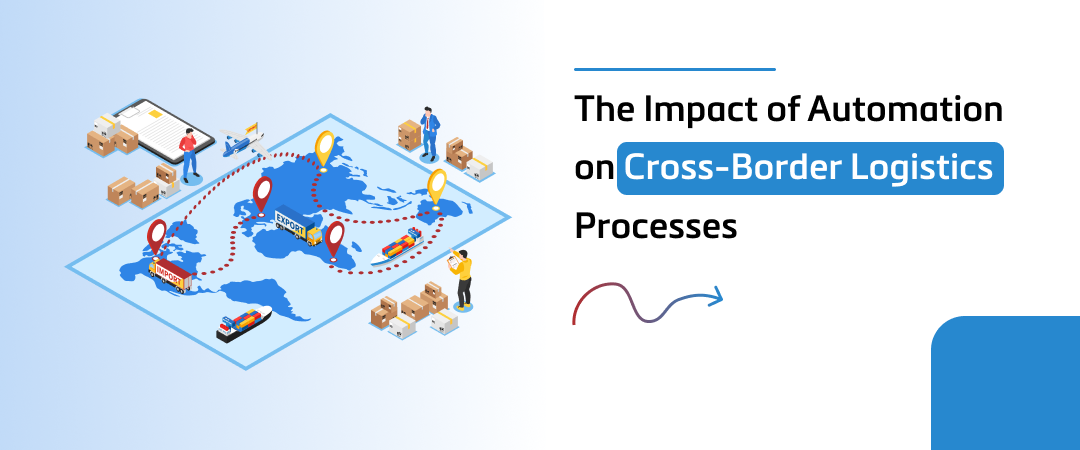
The Impact of Automation on Cross-Border Logistics Processes

As buyers go global in ecommerce, brands must strive for clarity and efficiency. They anticipate fast delivery times despite the worldwide supply chain glitches which increase the cost of production and custom clearance challenges. While it comes to border-crossing logistics, finding the right technology helps to overcome hectic challenges and streamline your logistics operation
This is where automation can make a real difference. With integration automation for logistics, businesses can streamline cross-border processes and boost their efficiency.
In this blog, we will discuss the challenges faced in logistics and the role of automation in overcoming those challenges. Before diving into this topic, let’s have an overview of what cross-border logistics is.
What is Cross-Border Logistics?
Cross-border logistics is that part of a supply chain dealing specifically with the effective flow of products as they move from one country to another. Other than transportation, it aims to ease compliance with the applicable legal and tax requirements during the shipment of goods across international borders.
Looking to Automate your Logistics? | Reach Us WhatsApp
Common Challenges of Cross-Border Logistics
As logistics business expands into new markets, they face various challenges. Here are the common challenges involved in cross-border logistics.
1. Customs Clearance
To handle the complexities of customs clearance, it’s necessary to consider various regulations and documentations with attention to detail. That means all paperwork must be done correctly by understanding international trade laws in their details.
2. Variability of Tariffs and Taxes
Pricing in international trade becomes more complicated due to different tariff structures and tax policies. This requires businesses’ strategies for ensuring compliance and cost optimization.
3. Regulatory Compliance
One cannot avoid proactive measures given regulatory changes for a stable operation as well as compliance. Therefore, strong protocols with clear guidelines need to be established to adapt for regulatory changes instantly. By doing so, one can easily adapt to changes promptly by constantly looking up for updates.
4. Inventory Management
For successful inventory management there are accurate forecasting and continuous tracking activities involved. Hence, logistics business must make best use of technological advancements to streamline their logistics operations and optimize stock levels.
The Role of Automation in Overcoming Cross-Border Logistics Challenges
1. Streamlining Customs Clearance
Smooth custom clearance is a significant yet challenging part of cross-border logistics. To guarantee adherence to the set-down rules and regulations and not leave any rare possibility of delay in the clearance and the occurrence of penalties, logistics business must work through all these hurdles very carefully. Automation does this through:
Automated Documentation Generation: The automation program can generate precise and compliant shipping documents with a reduced risk of human error-in a process that often results in customs delays.
Real-Time Compliance Updates: Advanced automation follows up on changes in the international trade regulations and updates compliance checks in real-time to make sure that the shipment is always in accordance with the latest requirements.
Electronic Data Interchange (EDI): EDI supports electronic transmission of customs documentation. This speeds up the process of clearance and trims down the effort and paperwork.
2. Managing Tariff and Tax Variability
Dealing with the variability of tariffs and taxes is a great challenge.
Diverse tariff frameworks and multiple tax policies bring complexity into international trade transactions. Automation manages these intricacies with the following features:
Automated Tariff Calculations: Advanced software can calculate automatically within tariff and tax regulations for accurate pricing and compliance.
Optimized Cost Structures: Automation tool will run different cost scenarios to then advise on the most cost-effective strategies in tariff and tax management to optimize their price structures.
Dynamic Updates: Logistics businesses will be updated in real time regarding any changes in tariff and tax regulations by automated systems providing those updates in time, thereby enabling an organization to quickly adapt to them.
Looking to Automate your Logistics? | Reach Us WhatsApp
3. Ensuring Regulatory Compliance
With a constantly changing regulatory environment, regulatory compliance will always be a challenge. Automation can guarantee the implementation of different regulatory protocols by:
Setting Up Strong Protocols: Automated systems set the most important guidelines and protocols, ensuring a fast adjustment in case of any kind of regulatory change.
Continuous Monitoring: Automation will monitor each and every update within the regulatory framework, helping logistics businesses to innovate and change along with it.
4. Improving Returns and Reverse Logistics
Returns management is confronted with various regulatory and logistic issues. Automation enhances returns management by: An automated returns management system makes this process easier; customers can easily initiate a return, and companies effortlessly process the return.
Streamlined processes: This enables an easier way for customers to create a return and for businesses to process those efficiently.
Data-driven insight: Automatically use systems for deeper insights from return data into the core problems happening over and over, and act against them to bring changes to products and reduce return rates.
Conclusion
The key to curtailing the barriers facing cross-border logistics lies in automation. The more global logistics industry evolves, the greater the avenue for automation-leveraged businesses to take advantage of international opportunities and give leading customer experiences that lead to long-term success.
Investing in automation will enhance your logistics to stay updated along with the changing times. Morover, it give you opportunities to allow more productive changes in your logistics business. Are you prepared to streamline your logistics business? Find out how cross-border logistics automation can elevate your business.
Looking to Automate your Logistics? | Reach Us WhatsApp














